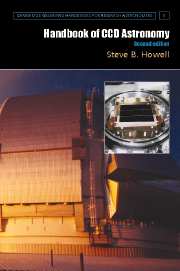Book contents
- Frontmatter
- Contents
- Preface to the first edition
- Preface to the second edition
- 1 Introduction
- 2 CCD manufacturing and operation
- 3 Characterization of charge-coupled devices
- 4 CCD imaging
- 5 Photometry and astrometry
- 6 Spectroscopy with CCDs
- 7 CCDs used in space and at short wavelengths
- Appendices
- References
- Index
3 - Characterization of charge-coupled devices
Published online by Cambridge University Press: 05 June 2012
- Frontmatter
- Contents
- Preface to the first edition
- Preface to the second edition
- 1 Introduction
- 2 CCD manufacturing and operation
- 3 Characterization of charge-coupled devices
- 4 CCD imaging
- 5 Photometry and astrometry
- 6 Spectroscopy with CCDs
- 7 CCDs used in space and at short wavelengths
- Appendices
- References
- Index
Summary
Even casual users of CCDs have run across the terms read noise, signal-to-noise ratio, linearity, and many other possibly mysterious sounding bits of CCD jargon. This chapter will discuss the meanings of the terms used to characterize the properties of CCD detectors. Techniques and methods by which the reader can determine some of these properties on their own and why certain CCDs are better or worse for a particular application are discussed in the following chapters. Within the discussions, mention will be made of older types of CCDs. While these are generally not available or used anymore, there is a certain historical perspective to such a presentation and it will likely provide some amusement for the reader along the way.
One item to keep in mind throughout this chapter and in the rest of the book is that all electrons look alike. When a specific amount of charge is collected within a pixel during an integration, one can no longer know the exact source of each electron (e.g., was it due to a stellar photon or is it an electron generated by thermal motions within the CCD itself?). We have to be clever to separate the signal from the noise. There are two notable quotes to cogitate on while reading this text. The first is from an early review article on CCDs by Craig Mackay (1986), who states: “The only uniform CCD is a dead CCD.”
- Type
- Chapter
- Information
- Handbook of CCD Astronomy , pp. 36 - 65Publisher: Cambridge University PressPrint publication year: 2006



